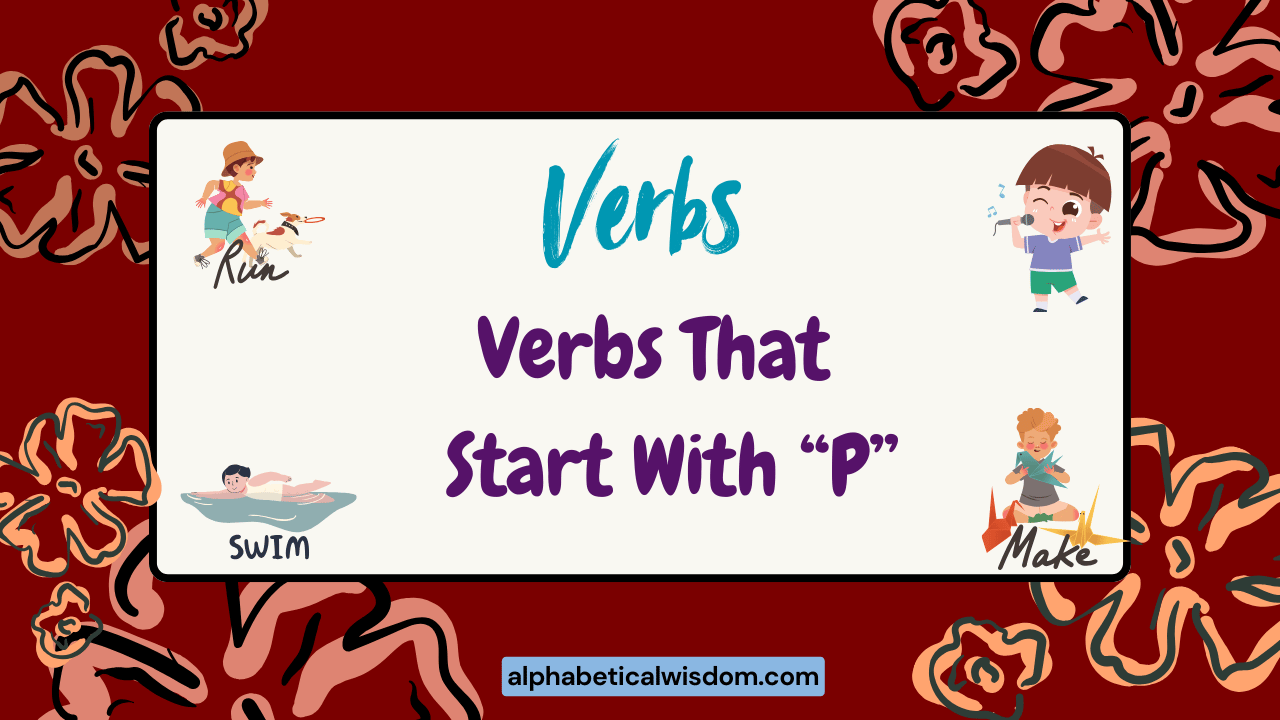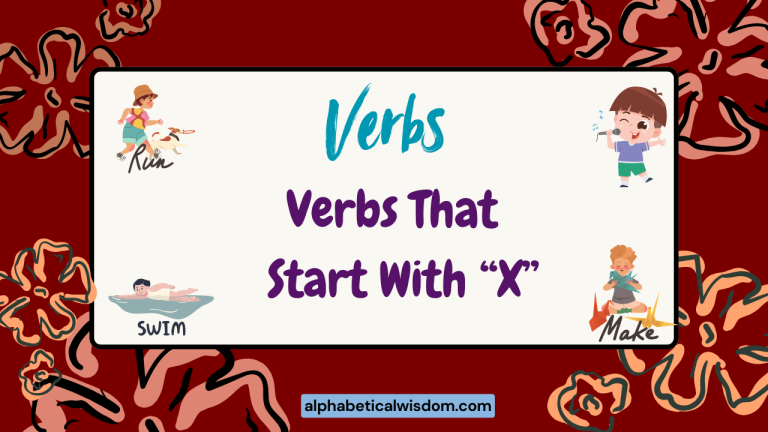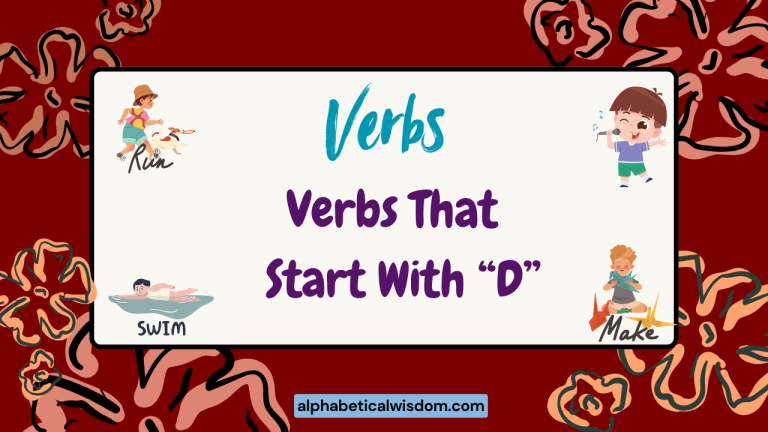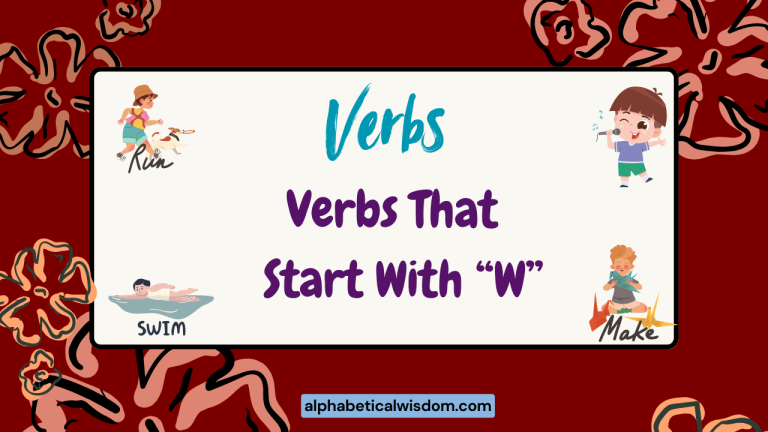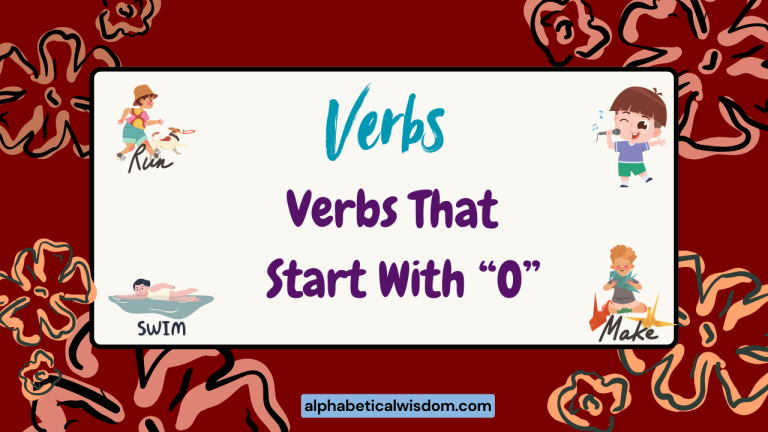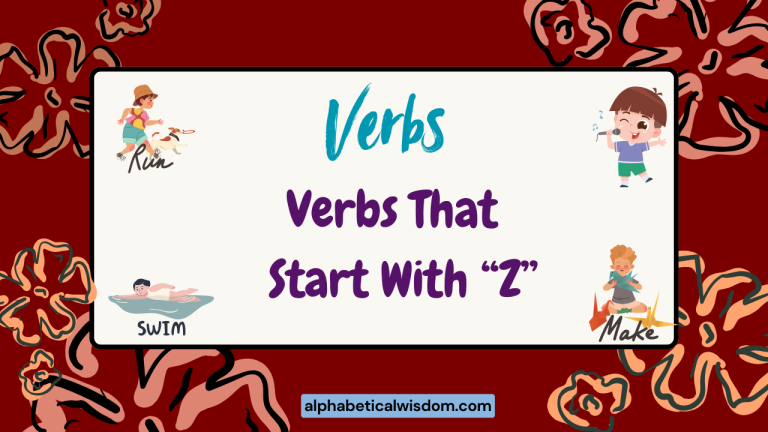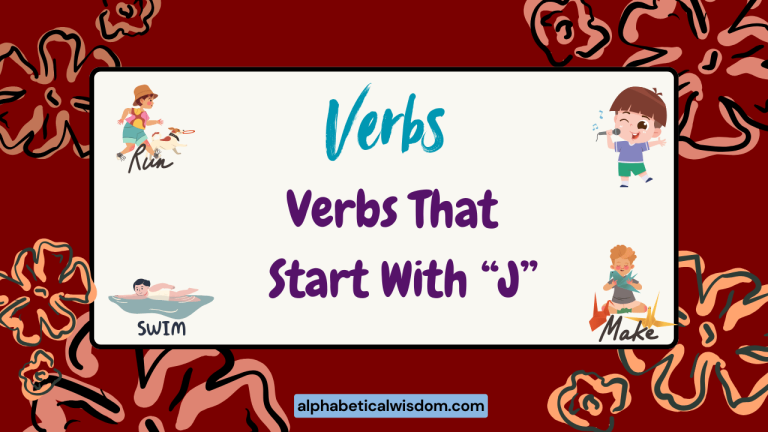Verbs Starting with P: A Comprehensive Guide
Understanding verbs is crucial for mastering English grammar. Verbs that start with the letter “P” are particularly diverse, covering a wide range of actions, states, and occurrences.
This article provides a comprehensive guide to these verbs, exploring their definitions, structures, usage rules, and common mistakes. Whether you’re a beginner or an advanced learner, this resource will help you enhance your vocabulary and improve your command of the English language.
Table of Contents
- Introduction
- Definition of Verbs Starting with P
- Structural Breakdown
- Types and Categories of Verbs Starting with P
- Examples of Verbs Starting with P
- Usage Rules
- Common Mistakes
- Practice Exercises
- Advanced Topics
- FAQ
- Conclusion
Definition of Verbs Starting with P
A verb is a word or group of words that describes an action, occurrence, or state of being. Verbs starting with “P” are no different, encompassing a wide variety of meanings and usages.
These verbs can describe physical actions, mental processes, states of existence, and more. Understanding the nuances of these verbs is essential for effective communication in English.
Verbs can be classified based on their function and how they interact with other parts of a sentence. For example, some verbs require a direct object (transitive verbs), while others do not (intransitive verbs).
Additionally, verbs can be categorized as action verbs (describing a physical or mental action) or stative verbs (describing a state of being or condition). Mastering these classifications will significantly improve your ability to use verbs starting with “P” correctly and effectively.
Structural Breakdown
The structure of a verb involves its different forms and how it changes to indicate tense, mood, and voice. Regular verbs follow predictable patterns, while irregular verbs have unique forms that must be memorized.
Understanding the principal parts of a verb—the base form, past simple, and past participle—is crucial for forming different tenses and grammatical constructions. For example, the verb “paint” is regular, with past simple “painted” and past participle “painted.” However, the verb “prove” is irregular and can have two forms “proved” or “proven” for the past participle.
Auxiliary verbs, also known as helping verbs, combine with main verbs to form compound tenses, passive voice, and questions. Common auxiliary verbs include “be,” “have,” and “do.” When used with verbs starting with “P,” these auxiliaries help to express different aspects of time and meaning.
For instance, “is painting” (present continuous), “has proved” (present perfect), and “did perform” (past simple emphatic) illustrate how auxiliary verbs work with main verbs to create more complex verb phrases.
Types and Categories of Verbs Starting with P
Action Verbs
Action verbs describe physical or mental actions. These verbs are dynamic and indicate that something is happening or being done.
They can be further divided into transitive and intransitive verbs, depending on whether they require a direct object.
Examples of action verbs starting with “P” include: pack, paint, participate, perform, play, point, polish, pour, practice, preach, prepare, print, proceed, process, produce, program, project, promise, promote, protect, provide, pull, pump, punch, purchase, push, put.
Stative Verbs
Stative verbs describe a state of being, a condition, or a mental state, rather than an action. These verbs typically do not take the continuous form (e.g., -ing ending) unless used in a different sense.
Examples of stative verbs starting with “P” include: possess, perceive, please, presume, ponder, prefer, presuppose.
Transitive Verbs
Transitive verbs require a direct object to complete their meaning. The direct object receives the action of the verb. Examples of transitive verbs starting with “P” include: pack (I pack my suitcase), paint (She paints a picture), polish (He polishes the shoes), prepare (They prepare dinner), print (We print the documents), produce (The factory produces cars), protect (The shield protects the knight), push (He pushes the door).
Intransitive Verbs
Intransitive verbs do not require a direct object. The action of the verb is complete in itself. Examples of intransitive verbs starting with “P” include: participate (They participate in the event), perform (He performs well), proceed (We proceed with caution), pause (She paused for a moment).
Phrasal Verbs
Phrasal verbs consist of a verb and a particle (a preposition or adverb) that together create a new meaning. The meaning of a phrasal verb is often different from the meaning of the individual words.
Examples of phrasal verbs starting with “P” include: pass away (to die), pass out (to faint), pay back (to return money), pick up (to lift), play down (to minimize), point out (to indicate), put off (to postpone), put up with (to tolerate), pack up (to tidy and store away).
Modal Verbs
Modal verbs are auxiliary verbs that express necessity, possibility, permission, or ability. While there aren’t many modal verbs starting with “P,” the concept is important to understand.
One can use “presume” in certain contexts with modal-like meanings, although it’s not a traditional modal verb.
Examples of Verbs Starting with P
Here are several tables containing example sentences using verbs that start with the letter “P”. These examples are categorized by tense to demonstrate how the verbs change form depending on the time frame.
The following table presents examples of verbs starting with “P” used in the simple present and present continuous tenses. These illustrate actions that happen regularly or are happening right now.
| Verb | Simple Present | Present Continuous |
|---|---|---|
| Paint | She paints landscapes. | She is painting a portrait now. |
| Participate | They participate in community events. | They are participating in the conference this week. |
| Perform | He performs on stage every Friday. | He is performing a new song tonight. |
| Play | The children play in the park. | The children are playing football. |
| Point | He points to the direction. | He is pointing to the map. |
| Polish | She polishes her shoes every week. | She is polishing the silver now. |
| Pour | He pours the milk into the glass. | He is pouring the sauce over the pasta. |
| Practice | They practice the piano daily. | They are practicing for the concert. |
| Preach | He preaches every Sunday. | He is preaching about love today. |
| Prepare | She prepares breakfast every morning. | She is preparing a special dinner. |
| He prints documents weekly. | He is printing the report now. | |
| Proceed | We proceed carefully. | We are proceeding with the plan. |
| Process | The factory processes raw materials. | The factory is processing the order. |
| Produce | The farm produces crops annually. | The farm is producing more this year. |
| Program | She programs computers. | She is programming a new app. |
| Project | They project future earnings. | They are projecting the sales for next quarter. |
| Promise | He promises to be on time. | He is promising a reward for good behavior. |
| Promote | The company promotes its products. | The company is promoting a new campaign. |
| Protect | She protects her children. | She is protecting the environment. |
| Provide | They provide assistance. | They are providing support to the victims. |
| Pull | He pulls the rope. | He is pulling the cart. |
| Pump | The heart pumps blood. | The heart is pumping faster during exercise. |
| Punch | The boxer punches the bag. | The boxer is punching the speed bag. |
| Purchase | They purchase groceries weekly. | They are purchasing a new car. |
| Push | He pushes the door open. | He is pushing the stroller. |
| Put | She puts the book on the table. | She is putting the dishes away. |
The following table presents examples of verbs starting with “P” used in the simple past and past continuous tenses. These examples show actions that happened in the past and actions that were ongoing at a specific time in the past.
| Verb | Simple Past | Past Continuous |
|---|---|---|
| Paint | She painted a beautiful mural. | She was painting when the phone rang. |
| Participate | They participated in the marathon last year. | They were participating in the discussions all day. |
| Perform | He performed the play perfectly. | He was performing on stage when the lights went out. |
| Play | The children played in the snow. | The children were playing when it started to rain. |
| Point | He pointed at the suspect. | He was pointing out the landmarks. |
| Polish | She polished the silverware. | She was polishing the furniture when I arrived. |
| Pour | He poured the wine slowly. | He was pouring the drinks when guests arrived. |
| Practice | They practiced the song all night. | They were practicing when the storm began. |
| Preach | He preached about peace. | He was preaching when the earthquake struck. |
| Prepare | She prepared a feast. | She was preparing dinner when I called. |
| He printed the documents yesterday. | He was printing the report when the power went off. | |
| Proceed | We proceeded with the project. | We were proceeding carefully down the path. |
| Process | The factory processed the order quickly. | The factory was processing materials all night. |
| Produce | The farm produced a large harvest. | The farm was producing crops all summer. |
| Program | She programmed the software. | She was programming the code when she found the error. |
| Project | They projected future growth. | They were projecting sales when the news broke. |
| Promise | He promised to help. | He was promising her the world. |
| Promote | The company promoted the event. | The company was promoting the product heavily. |
| Protect | She protected her family. | She was protecting the children from the rain. |
| Provide | They provided assistance immediately. | They were providing support to the refugees. |
| Pull | He pulled the door shut. | He was pulling the weight at the gym. |
| Pump | The machine pumped water. | The machine was pumping water all day. |
| Punch | He punched the wall in anger. | He was punching the bag to relieve stress. |
| Purchase | They purchased a new house. | They were purchasing items at the store. |
| Push | He pushed the button. | He was pushing the car up the hill. |
| Put | She put the keys on the table. | She was putting the groceries away. |
The following table presents examples of verbs starting with “P” used in the future simple and future continuous tenses. These examples illustrate actions that will happen in the future and actions that will be ongoing at a specific time in the future.
| Verb | Future Simple | Future Continuous |
|---|---|---|
| Paint | She will paint a mural next year. | She will be painting the mural all day tomorrow. |
| Participate | They will participate in the conference. | They will be participating in the workshop. |
| Perform | He will perform at the concert. | He will be performing on stage at 8 PM. |
| Play | The children will play in the garden. | The children will be playing outside later. |
| Point | He will point out the error. | He will be pointing to the relevant data. |
| Polish | She will polish the silver. | She will be polishing the furniture all afternoon. |
| Pour | He will pour the tea. | He will be pouring drinks for the guests. |
| Practice | They will practice the routine. | They will be practicing for the competition. |
| Preach | He will preach the sermon. | He will be preaching about hope. |
| Prepare | She will prepare the presentation. | She will be preparing the meal for the party. |
| He will print the report. | He will be printing the labels tomorrow morning. | |
| Proceed | We will proceed with the investigation. | We will be proceeding with caution. |
| Process | The factory will process the order. | The factory will be processing the shipments overnight. |
| Produce | The farm will produce more crops. | The farm will be producing vegetables all summer. |
| Program | She will program the app. | She will be programming the new features. |
| Project | They will project the earnings. | They will be projecting sales figures next week. |
| Promise | He will promise to do better. | He will be promising solutions during the meeting. |
| Promote | The company will promote the new product. | The company will be promoting the event heavily. |
| Protect | She will protect her family. | She will be protecting the environment. |
| Provide | They will provide support. | They will be providing aid to the victims. |
| Pull | He will pull the lever. | He will be pulling the equipment to the site. |
| Pump | The machine will pump water. | The machine will be pumping water all night. |
| Punch | He will punch the code in. | He will be punching in the data. |
| Purchase | They will purchase tickets. | They will be purchasing new furniture soon. |
| Push | He will push the cart. | He will be pushing the box up the stairs. |
| Put | She will put the books away. | She will be putting the finishing touches on the project. |
This table shows examples of verbs starting with “P” in the present perfect and past perfect tenses, illustrating actions completed at an unspecified time before now or before a specific time in the past, respectively.
| Verb | Present Perfect | Past Perfect |
|---|---|---|
| Paint | She has painted several masterpieces. | She had painted the portrait before the exhibition. |
| Participate | They have participated in many events. | They had participated in the study before it was published. |
| Perform | He has performed on many stages. | He had performed the song before he released it. |
| Play | The children have played in the park. | The children had played all afternoon before they came inside. |
| Point | He has pointed out the flaws. | He had pointed out the errors before anyone else noticed. |
| Polish | She has polished the silver. | She had polished the furniture before the guests arrived. |
| Pour | He has poured the wine. | He had poured the water before the power went out. |
| Practice | They have practiced the piece. | They had practiced the routine before the competition. |
| Preach | He has preached the message. | He had preached the same sermon before. |
| Prepare | She has prepared the meal. | She had prepared dinner before I got home. |
| He has printed the documents. | He had printed the report before the meeting. | |
| Proceed | We have proceeded cautiously. | We had proceeded with the plan before the change. |
| Process | The factory has processed the shipment. | The factory had processed the materials before the inspection. |
| Produce | The farm has produced a good harvest. | The farm had produced a lot of crops before the drought. |
| Program | She has programmed the software. | She had programmed the system before the launch. |
| Project | They have projected the earnings. | They had projected the sales before the market crashed. |
| Promise | He has promised to help. | He had promised to be there before he forgot. |
| Promote | The company has promoted the product. | The company had promoted the event before it was canceled. |
| Protect | She has protected her children. | She had protected the data before the breach. |
| Provide | They have provided assistance. | They had provided support before the situation worsened. |
| Pull | He has pulled the lever. | He had pulled the rope before it snapped. |
| Pump | The machine has pumped the water. | The machine had pumped all night. |
| Punch | He has punched the ticket. | He had punched in before the shift started. |
| Purchase | They have purchased the car. | They had purchased the house before they moved. |
| Push | He has pushed the button. | He had pushed the door open before I arrived. |
| Put | She has put the books away. | She had put the groceries away before she left. |
Usage Rules
Tense Agreement
Tense agreement requires that the verbs in a sentence are consistent in time frame. This means ensuring that the tenses of the verbs logically relate to each other and accurately reflect the sequence of events.
For example, if the main verb is in the past tense, any subsequent verbs describing related actions should also be in the past tense.
Correct: She painted the picture after she prepared her materials. (Both verbs are in the past tense)
Incorrect: She paints the picture after she prepared her materials. (Inconsistent tenses)
Subject-Verb Agreement
Subject-verb agreement means that the verb must agree in number (singular or plural) with its subject. A singular subject takes a singular verb, and a plural subject takes a plural verb.
This is a fundamental rule of English grammar that ensures clarity and correctness in sentence construction.
Correct: He paints every day. (Singular subject “He” takes the singular verb “paints”)
Correct: They paint together. (Plural subject “They” takes the plural verb “paint”)
Incorrect: He paint every day.
Incorrect: They paints together.
Irregular Verbs
Irregular verbs do not follow the standard pattern of adding “-ed” to form the past simple and past participle. Instead, they have unique forms that must be memorized.
Many verbs starting with “P” are regular, but some can be tricky or have irregular forms in certain dialects (e.g., “prove,” which can have “proved” or “proven” as its past participle).
Example: The verb “prove” can be either regular or irregular depending on the context and dialect. In American English, “proven” is a common past participle, while in British English, “proved” is more common.
Correct: He has proved his point. (British English)
Correct: He has proven his point. (American English)
Gerunds and Infinitives
Gerunds are verbs ending in “-ing” that function as nouns. Infinitives are the base form of the verb preceded by “to.” Understanding when to use a gerund or an infinitive after a verb is crucial for correct grammar.
Example: He enjoys painting. (Gerund as the object of “enjoys”)
Example: He wants to paint. (Infinitive as the object of “wants”)
Common Mistakes
One common mistake is confusing the past simple and past participle forms of irregular verbs. For instance:
Incorrect: He has paint a picture.
Correct: He has painted a picture.
Another frequent error is incorrect subject-verb agreement:
Incorrect: She perform well.
Correct: She performs well.
Misusing phrasal verbs is also common, as their meanings are not always obvious from the individual words:
Incorrect: He put off the fire. (Intended meaning: extinguish)
Correct: He put out the fire. (Correct phrasal verb)
Practice Exercises
Exercise 1: Fill in the Blanks with the Correct Form of the Verb
| Question | Answer |
|---|---|
| 1. They ________ (participate) in the competition last year. | participated |
| 2. She is ________ (prepare) dinner right now. | preparing |
| 3. He will ________ (perform) on stage tomorrow. | perform |
| 4. We have ________ (proceed) with caution. | proceeded |
| 5. The factory ________ (produce) goods daily. | produces |
| 6. She ________ (promise) to help us. | promised |
| 7. They are ________ (protect) the environment. | protecting |
| 8. He ________ (pull) the door open. | pulled |
| 9. She ________ (purchase) a new car. | purchased |
| 10. They ________ (put) the books on the shelf. | put |
Exercise 2: Correct the Errors in the Following Sentences
| Incorrect Sentence | Correct Sentence |
|---|---|
| 1. She paint a picture every day. | She paints a picture every day. |
| 2. They was participating in the event. | They were participating in the event. |
| 3. He has perform the song. | He has performed the song. |
| 4. We proceed with caution yesterday. | We proceeded with caution yesterday. |
| 5. The factory produce the goods. | The factory produces the goods. |
| 6. She promise to come. | She promised to come. |
| 7. They is protecting the forest. | They are protecting the forest. |
| 8. He pull the rope. | He pulled the rope. |
| 9. She purchase a ticket. | She purchased a ticket. |
| 10. They puts the dishes away. | They put the dishes away. |
Exercise 3: Use the Correct Tense of the Verb in Parentheses
| Question | Answer |
|---|---|
| 1. By the time I arrived, she ________ (prepare) dinner. | had prepared |
| 2. He ________ (perform) on stage when the lights went out. | was performing |
| 3. They ________ (participate) in the conference next week. | will participate |
| 4. She ________ (paint) a beautiful landscape last year. | painted |
| 5. He ________ (point) out the flaws in the design. | pointed |
| 6. She ________ (polish) the silver every month. | polishes |
| 7. They ________ (practice) the song all night. | practiced |
| 8. He ________ (preach) the sermon every Sunday. | preaches |
| 9. She ________ (print) the documents yesterday. | printed |
| 10. We ________ (proceed) with the plan after the meeting. | will proceed |
Advanced Topics
Subjunctive Mood
The subjunctive mood is used to express wishes, suggestions, commands, or conditions that are contrary to fact. It often appears in “that” clauses after verbs such as “suggest,” “demand,” “insist,” and “recommend.”
Example: I suggest that he participate in the workshop. (Subjunctive mood)
Passive Voice
The passive voice is used when the subject of the sentence receives the action, rather than performing it. It is formed using a form of the verb “be” and the past participle of the main verb.
Verbs starting with “P” can be used in the passive voice to shift the focus of the sentence.
Example: The painting was painted by Van Gogh. (Passive voice)
Example: The project will be promoted by the team.
FAQ
- What is the difference between transitive and intransitive verbs?
Transitive verbs require a direct object to complete their meaning (e.g., “She paints a picture”). Intransitive verbs do not require a direct object (e.g., “They participate”).
- How do I know if a verb is regular or irregular?
Regular verbs form their past simple and past participle by adding “-ed.” Irregular verbs have unique forms that must be memorized. If a verb does not follow the “-ed” pattern, it is irregular.
- What is a phrasal verb, and how do I use it correctly?
A phrasal verb is a combination of a verb and a particle (preposition or adverb) that creates a new meaning. To use them correctly, you need to learn the specific meaning of each phrasal verb and how it functions in a sentence. For example, “put off” means “to postpone,” which is different from “put” alone.
- When should I use the present perfect tense?
Use the present perfect tense to describe an action that started in the past and continues to the present, or an action that happened at an unspecified time before now and has a connection to the present. For example, “I have painted several pictures” (action completed at an unspecified time).
- What is subject-verb agreement, and why is it important?
Subject-verb agreement means that the verb must agree in number (singular or plural) with its subject. It is important for clear and correct communication in English. For example, “He paints” (singular) versus “They paint” (plural).
- Can a verb be both transitive and intransitive?
Yes, some verbs can be both transitive and intransitive, depending on how they are used in a sentence. For example, “He plays the guitar
(transitive)” versus “He plays (intransitive).”
Conclusion
Verbs starting with the letter “P” offer a rich and varied selection for expressing actions, states, and occurrences in the English language. By understanding their definitions, structural nuances, and usage rules, you can significantly enhance your communication skills.
This guide has provided a comprehensive overview, covering everything from basic definitions to advanced topics like the subjunctive mood and passive voice. Consistent practice and attention to common mistakes will further refine your ability to use these verbs effectively and accurately.
Embrace the challenge, and continue to explore the fascinating world of English verbs.
